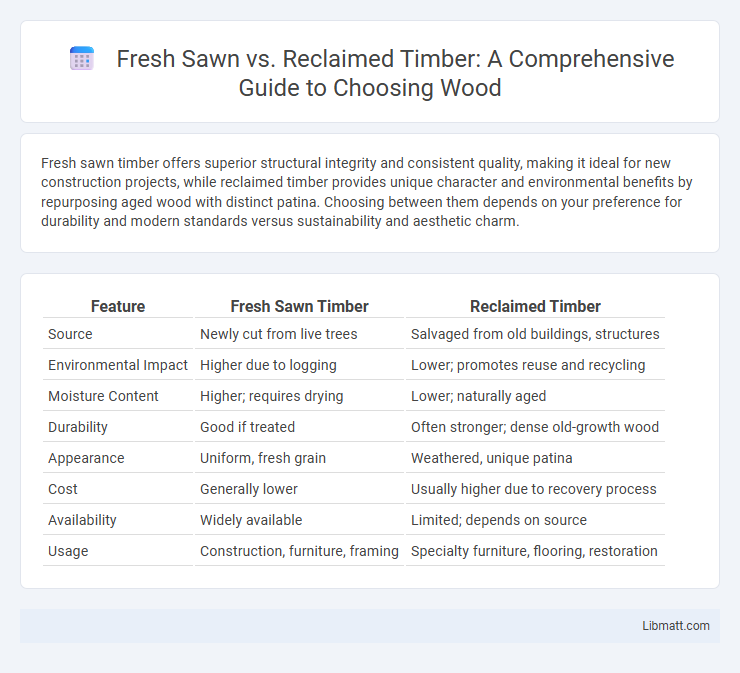Fresh sawn timber offers superior structural integrity and consistent quality, making it ideal for new construction projects, while reclaimed timber provides unique character and environmental benefits by repurposing aged wood with distinct patina. Choosing between them depends on your preference for durability and modern standards versus sustainability and aesthetic charm.
Table of Comparison
| Feature | Fresh Sawn Timber | Reclaimed Timber |
|---|---|---|
| Source | Newly cut from live trees | Salvaged from old buildings, structures |
| Environmental Impact | Higher due to logging | Lower; promotes reuse and recycling |
| Moisture Content | Higher; requires drying | Lower; naturally aged |
| Durability | Good if treated | Often stronger; dense old-growth wood |
| Appearance | Uniform, fresh grain | Weathered, unique patina |
| Cost | Generally lower | Usually higher due to recovery process |
| Availability | Widely available | Limited; depends on source |
| Usage | Construction, furniture, framing | Specialty furniture, flooring, restoration |
Introduction to Fresh Sawn and Reclaimed Timber
Fresh sawn timber is wood that is newly cut from logs, retaining its natural moisture content and offering a clean, uniform appearance ideal for construction and woodworking. Reclaimed timber originates from salvaged old structures, providing unique character, increased durability, and environmental benefits by repurposing aged wood. Both types serve different aesthetic and functional needs, with fresh sawn prized for consistency and reclaimed valued for its history and sustainability.
Understanding the Differences: Fresh Sawn vs Reclaimed Timber
Fresh sawn timber refers to wood that has been newly cut from trees and is typically higher in moisture content, offering a clean, uniform appearance ideal for construction requiring strength and stability. Reclaimed timber is sourced from previously used wood, often salvaged from old buildings or furniture, possessing unique character, weathered textures, and enhanced environmental sustainability by reducing the demand for new lumber. Choosing between fresh sawn and reclaimed timber depends on project requirements, balancing structural integrity, aesthetic appeal, and ecological impact.
Source and Availability of Each Timber Type
Fresh sawn timber is sourced directly from recently felled trees, making it widely available through sawmills and forestry operations, often in consistent dimensions and quality. Reclaimed timber comes from salvaged wood structures like old barns, factories, or warehouses, providing limited and variable availability depending on the salvage site's supply and demand. Your choice depends on whether you prioritize steady access and uniformity with fresh sawn or environmental sustainability and unique character with reclaimed timber.
Environmental Impact: Sustainability and Resource Management
Fresh sawn timber involves harvesting trees directly from forests, which can lead to deforestation and habitat loss if not managed sustainably, whereas reclaimed timber repurposes wood from old structures, significantly reducing demand for new logging and minimizing environmental disruption. Reclaimed timber promotes circular economy principles by diverting wood waste from landfills and lowering carbon emissions associated with tree harvesting and processing. Sustainable forest certifications like FSC ensure responsible resource management for fresh sawn timber, but reclaimed timber inherently embodies sustainability through reuse and conservation of natural ecosystems.
Characteristics and Properties Comparison
Fresh sawn timber offers a vibrant appearance with higher moisture content, making it easier to shape but susceptible to warping and shrinkage over time. Reclaimed timber features a weathered, aged texture with enhanced stability and reduced moisture, often containing unique markings and a denser grain due to years of exposure and use. Your choice depends on whether you prioritize the new wood's pliability or the reclaimed timber's durability and distinctive character.
Aesthetic Appeal and Design Versatility
Fresh sawn timber offers a clean, uniform appearance with prominent natural grain patterns, making it ideal for modern and contemporary design projects that require a sleek, polished look. Reclaimed timber provides a unique, weathered aesthetic with varied textures and rich history, enhancing rustic or vintage interiors by adding character and warmth. Your choice between the two depends on whether you prioritize the fresh, consistent appearance of new wood or the distinctive charm and design versatility of aged materials.
Cost Factors: Initial and Long-Term Expenses
Fresh sawn timber typically incurs lower initial costs due to its direct milling process and widespread availability, making it more affordable for new construction. Reclaimed timber often demands higher upfront expenses because of the labor-intensive sourcing, de-nailing, and restoration processes, but it offers long-term value through durability and unique aesthetic appeal that can increase property value. Maintenance and replacement costs tend to be lower with reclaimed timber due to its aged and stabilized nature, reducing the need for frequent upkeep compared to fresh sawn wood.
Durability, Strength, and Performance
Fresh sawn timber offers superior strength and durability due to its higher moisture content and intact cellular structure, making it ideal for structural applications requiring long-term performance. Reclaimed timber, while potentially slightly less strong, provides enhanced stability and resistance to warping as it has already undergone natural seasoning and drying processes. Your choice should balance the need for raw strength in fresh sawn wood against the dimensional stability and eco-friendly benefits of reclaimed timber.
Ideal Applications for Fresh Sawn and Reclaimed Timber
Fresh sawn timber is ideal for construction projects requiring uniform strength and moisture content, such as framing, flooring, and cabinetry, ensuring structural integrity and predictable performance. Reclaimed timber suits aesthetic and eco-friendly applications, including decorative wall paneling, furniture, and accent pieces, offering unique character and historical value. Both types provide sustainable options, with fresh sawn timber optimal for new builds and reclaimed timber perfect for renovations or design-conscious projects.
Making the Right Choice: Factors to Consider
When deciding between fresh sawn and reclaimed timber, consider factors like environmental impact, durability, and budget. Fresh sawn timber offers consistent quality and easier customization, while reclaimed timber provides unique aesthetics and sustainability benefits by reusing aged wood. Your choice should align with project requirements, desired appearance, and long-term performance expectations.
Fresh sawn vs reclaimed timber Infographic

 libmatt.com
libmatt.com